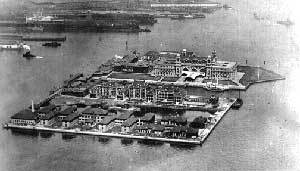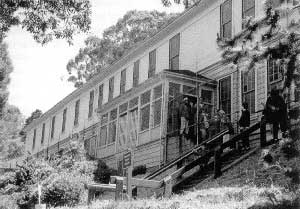|
.gif)

Cover Page
MENU
Table of Contents
Abstract
Acknowledgments
Introduction
Essay
Brief History
Gila River
Granada
Heart Mountain
Jerome
Manzanar
Minidoka
Poston
Rohwer
Topaz
Tule Lake
Isolation Centers
Add'l Facilities
Assembly Centers
 DoJ and
DoJ and
US Army Facilities
Prisons
References
Appendix A
Appendix B
Appendix C
|
|
|
|
Confinement and Ethnicity:

An Overview of World War II
Japanese American Relocation Sites
by J. Burton, M. Farrell, F. Lord, and R. Lord
|

|
|
Chapter 17 (continued)
Department of Justice and U.S. Army Facilities
Temporary Detention Stations

Figure 17.1. Air view of Ellis Island, 1993.
(California Museum of Photography, University of California, Riverside)
|
The Issei who were apprehended by the FBI as soon as the U.S. entered
the war were first held at various "temporary" locations prior to being
sent to more permanent facilities. The temporary detention stations were
located at Angel Island, San Pedro, Sharp Park, and Tuna Canyon in
California, and Ellis Island, New York, East Boston, Massachusetts,
Cincinnati, Ohio, and Seattle, Washington (Weglyn 1976). The two most
prominent locations were the immigration stations at Ellis Island and
Angel Island.
Ellis Island, a mostly artificial island of about 27
acres in Upper New York Bay, has been government property since 1808.
Between 1892 and 1941 it served as the chief entry station for
immigrants to the United States. During World War II it was used as a
detention center to hold enemy aliens awaiting hearings. In December
1941 Ellis Island held 279 Japanese, 248 Germans, and 81 Italians, all
removed from the East Coast (Figure 17.1). Thereafter several hundred
detainees, mostly German and Italian nationals, were brought to Ellis
Island each month. Most were transferred or released within 1 to 4
months, however some were held for up to 2 years. In February 1944 there
were only three Japanese Americans still being held there and in June
1944 only one Japanese American (Jacobs 1997). The immigration center is
now run as a museum by the National Park Service.

Figure 17.2. Detainee barracks at the Angel Island Immigration Station.
(Angel Island Foundation)
|
The Angel Island immigration station is known as the "Ellis Island of
the West." The 740-acre island is in the western part of San Francisco
Bay. The immigration station, on the north side of the island, was
opened in 1910 to handle an expected flood of European immigrants after
the opening of the Panama Canal (Figure 17.2). Instead, the vast
majority of immigrants were from Asia, including 175,000 Chinese and
100,000 Japanese. The immigration station was closed in 1940 after the
administration building burned down. The property was then turned over
to the U.S. Army, which used it as a POW processing center. For a short
time one of the barracks at the facility was used to house enemy aliens.
Buildings remaining at the site today include a detention barracks, two
military barracks, a guard tower, a hospital building, and the power
plant. Today a museum is located in the detention barracks. It includes
a re-creation of one of the dormitories featuring some of the many poems
carved into the walls by Chinese immigrants. The second floor of the
barracks has several inscriptions written by Japanese and German POWs
(Quan 1999).
Continued

|
|
|




 Top
Top
![]()

